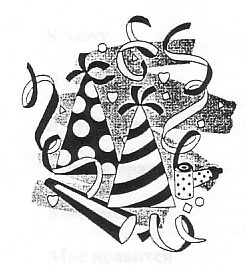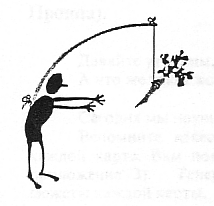 TRIZ
Textbooks: CID Course for Children, 1-2G0123 TRIZ
Textbooks: CID Course for Children, 1-2G0123 |
  
|
| Invitation
to the Fairy Tale
Topic 1.
Fairy Tales about Systems
Topic 2.
Fairy Tales from the Word "Why?"
Topic 3.
"Spoiled" Fairy Tales |
Fairy Tales
School:
Course of Creative Imagination
Development (CID),
1st Grade, 2nd Semester,
Methodical Guide-Book |
Natalia
V. Rubina, 1999 [published
in Russian]
English
translation by Irina Dolina,
March 13, 2001
Technical
Editing by Toru Nakagawa, May
1, 2001 |
Posted
in this "TRIZ Home Page in Japan" in English on May 8, 2001 under the permission
of the Author.
(C) N.V. Rubina,
I. Dolina, and T. Nakagawa 2001 |
 |
Invitation
to the Fairy Tale
(Introductory
Lesson) |
Workbook
The
CID classes during the second semester of the first grade are devoted to
the method of creating the fairy tales. The first aim of the first
lesson is to place the children into the atmosphere of a fairy tale, to
teach them to see fairy tales’ characters around them. In the folk
tales the relationship and the value of the people, who created these tales
are reflected as in a mirror. Maybe we will manage to transfer
our ideas about life through the fairy tales.
1. Warming-up
(See Card Index to the CID classes
for the first grade, part 2)
2. Home work
The characters of the
first part of the Workbook,
 i.e., Colabo, Emil, and Magician Deli-Davai, were good helpers
for our mastering the difficult methods. The fairy tale goes on and
our true friends stay with us. Try to make up the riddles about
each of the characters.
i.e., Colabo, Emil, and Magician Deli-Davai, were good helpers
for our mastering the difficult methods. The fairy tale goes on and
our true friends stay with us. Try to make up the riddles about
each of the characters.
3. Introduction to the lesson
Have you ever been in
a fairy tale?
Once upon a time
there was a king…
In a far away country,
where the sun rises and the flowers open earlier than everywhere
else…
And what is the other
way to begin a tale? How to start a fairy tale about our class?
A fairy tale
as any other system consists of the parts. The simple task to make
up a beginning of a new fairy tale allows to define one of the parts and
from the beginning to set up a conversation based on “a fairy tale language”.
4. Main Topic
There is a fairy tale
in our class room; everything here is magic. Our blackboard , for
example, can make up riddles.
 |
The crayfish drawn on the blackboard , crawls
up.
One has to move three matches so that it crawls
down |
 |

Activity 1. Prove that everything
in our class-room is magic.
In the children’s imagination the ordinary objects may become magic.
Here are some examples of the children’s comparisons. The desks are
the small stubs, on which in a magic forest classes are held; the walls
are the giant trees; the curtains on the windows are the magic mist; and
the books can retell amazing stories.

Activity 2. Listen. We often
stop paying attention to the sounds, that surround us, especially
if we are busy. Let’s listen to a silence for a minute. Explain
in a magic way what you have heard.

Activity 3. I am rubbing my
hands. Why do you think I am doing it?
When I am rubbing my
hands, I am calling the rain.
Find a magic explanation
for the ordinary actions.
Doing
this activity the children often copy each other. Pay attention to
this. If the explanations start to repeat themselves, offer another
idea, which will give the children’s fantasy a different direction.
6. Activities on the speech development
or producing a creative product 
Make a picture of your
class fairy tale.
7. Sum up
A fairy tale can be everywhere;
A fairy tale, as any
other system, consists of some stuff;
A fairy tale can be seen,
heard, felt;
Everything in a fairy
tale is interrelated.
|
Topic
1. Fairy Tales about Systems
(Reviewing) |
Workbook
1. Warming- up
To match incompatible.
"I am thinking about
a magic word…"
2. Home-work
Pictures and comments
to them.
3. Introduction to the lesson
I see a bonfire
I hear it cracks
I feel that it is not hot.
I don’t like that it is far from me.
I feel funny because it is green
I like that it is spread.
What was I talking about?
How did you guess?
4. Main Topic 
Pay attention to this:
some of you have seen, others have heard, someone has
felt the bonfire.
Presenting this riddle,
I have chosen the properties that remind us of a flower.
I used the following diagram.
I see
I hear
I feel
I don’t like
I feel funny
I like |
6. Activities on speech development
and designing a creative product 
Make a picture of your riddle.
7. Sum up
The pictures of the mysterious
objects can be put on the same piece of paper. You’ll get a map of
a magic world, where you have placed yourself.
|
Topic 2.
Fairy Tales from the Word "Why?" |
Workbook
1. Warming- up
To match incompatible
“I am thinking about
a magic word…”
2. Home work
Children’s riddles.
3. Introduction to the lesson
We learned to explain
in a magic way the most common things. Today we’ll make use of it.
Do you know why it rains?
Why is a hedgehog prickly?
A good story teller told
us lots of tales, explaining why a camel had a hump, why a whale has such
teeth. Do you want to listen to this story?
(See Card index to
CID lessons for the first grade, part 2.)
How those fairy tales
appear?
Let’s find out.
This diagram will help us.
1. Choose any system,
unusual property or interesting thing (HAS BECOME).
2. Imagine that
some time ago everything was different (WAS).
3. Explain, why
it has happened.
The method
"Fairy tales from the word “why?”" is rather simple. The children
will surprise you with the unexpected interpretations of the most common
things. Often this method becomes one the favorite children’s
games, that they can play with their friends and relatives.
In some classes, applying
this method, I discovered a strong psychological inertia. It
was caused by the fact that the children couldn’t get over their familiar
“logical” explanations of the phenomenon of the world around. The
following activity will help to stir up the kids’ imagination, to direct
their fantasy against psychological inertia. The diagram (WAS – HAS
BECOME) is a script which we have already learned to use. Let’s
play every step. Try to feel yourself a character of a fairy tale
(imagine how he moves, talks, what he wants). What sounds surround
your character? What does your character see around him? And
now, answering the questions: how and why your character has changed? -
remember , what you have heard, seen, felt. (A small comment.
This game will be even more interesting if the children choose an
inanimate object as a character.)
6. Activities on speech developing
or designing a creative product 

Write your own fairy
tale and make pictures for it.
 |
Topic
3. "Spoiled" Fairy Tales
|
Workbook
1. Warming up
To match incompatible.
"I am thinking about
a magic word ."
2. Home work
The Children's fairy tales.
3. Introduction to the lesson
"Once upon a time there
was a girl whose name was Yellow Riding Hood…"
"Not Yellow, but Red!"
"Oh, yes, Red.
So, her father called her and…"
"No, not her father,
but her mother!"
"That's correct.
Her mother called her and said: go to aunt Rosine and bring her…"
"No, not to her aunt,
but to her grandmother…"
And so on.
The idea of
"garbling" of a fairy tale belongs to J.Rodari, the famous Italian story
teller and teacher. This method allows us to see that a fairy tale,
as any other system, consists of the parts, these parts are interrelated.
"Garbling" the tale, the children find the main and subordinate parts of
the tale, and learn how to make up the plot.
"The game is more important
than one can realize at first sight. What we need is to choose for
it an appropriate moment. The kids remain conservative for a long
time if it refers to the fairy tales. They want the fairy tales to
be told to them with the same words they were told for the first
time. It is pleasant for them to recognise these words, step by step
to follow the plot, to feel excitement as for the first time in the same
order: surprise, fear, reward.
The children need order
and peace, the world shouldn't collaps from the stage that was built by
their efforts.
That is why it is possible
that in the beginning the game of "garbling" the fairy tales will
irritate, stir them. A kid is ready to the Wolf's apparance, but
the appearance of an unknown character might make him watchful, as it is
not clear whether this character is a friend or an enemy.
But the moment arrives
when Red Riding Hood has nothing more to say to the kid: he can part with
her. As in case of an old toy, that was not useful any more.
At this stage stage he agrees that it can be transfered into a parody,
partly because a parody means parting, and because a new perspective stirs
interest to the tale itself.
Put on a different
track, a familiar tale makes a child live it over again. The children
play not only with Red Riding Hood but with themselves, let themselves
be independent, take responsibility for what might happen. Here an
adult has to be ready to a healthy' arsessive behavior of a kid., to any
kind of absurd things.
In some cases this
game might have a sanitation impact. It will help a child to get
rid of some obsessive ideas, will teach not to fear the wolf, to see a
wood-goblin less villainous and a witch in a funny way, to eatablish a
more accurate border between a real world, where such independence is not
accaptable, and a world of imagination. It must happen sooner or
later: but of course no sooner than a wolf, a woo-goblin and a witch perform
their traditional missiion, but, naturally, not too late.
The second serious
aspect of the game is in the fact that a paticipant has to analyse a fairy
tale using his intuition. An alternative or a parody may be accepted
only in some defenite points, which are typical for that particular tale,
define its structure, but not in a course of a smooth development of a
contest from one content point to another. Compositional and decompositional
operations in this game take place simultaniously. That is why such
interference may be called operative and not abstract - logical.
As a result a fantasy is scarce and seldom leads to a new synthesis with
a new logic, this is more like a wandering around fairy tales' topics without
a certain aim, just like one who, instead of drawing , writes scibles."
J. Rodari: "Grammar
of Fantasy. Introduction into the Art of making up stories", Progress,
Moscow, 1999, pp. 57-59.
4. Main topic.
Try to "spoil" popular
fairy tales.
1. Choose a fairy tale.
2. Retell it in a "spoiled" way.
3. Guess what fairy tale it is.
6. Activities on speech development or designing
a creative product. 

.
Make a picture of a "spoiled" fairy tale.
Last updated
on May 8, 2001. Access point: Editor: nakagawa@utc.osaka-gu.ac.jp







